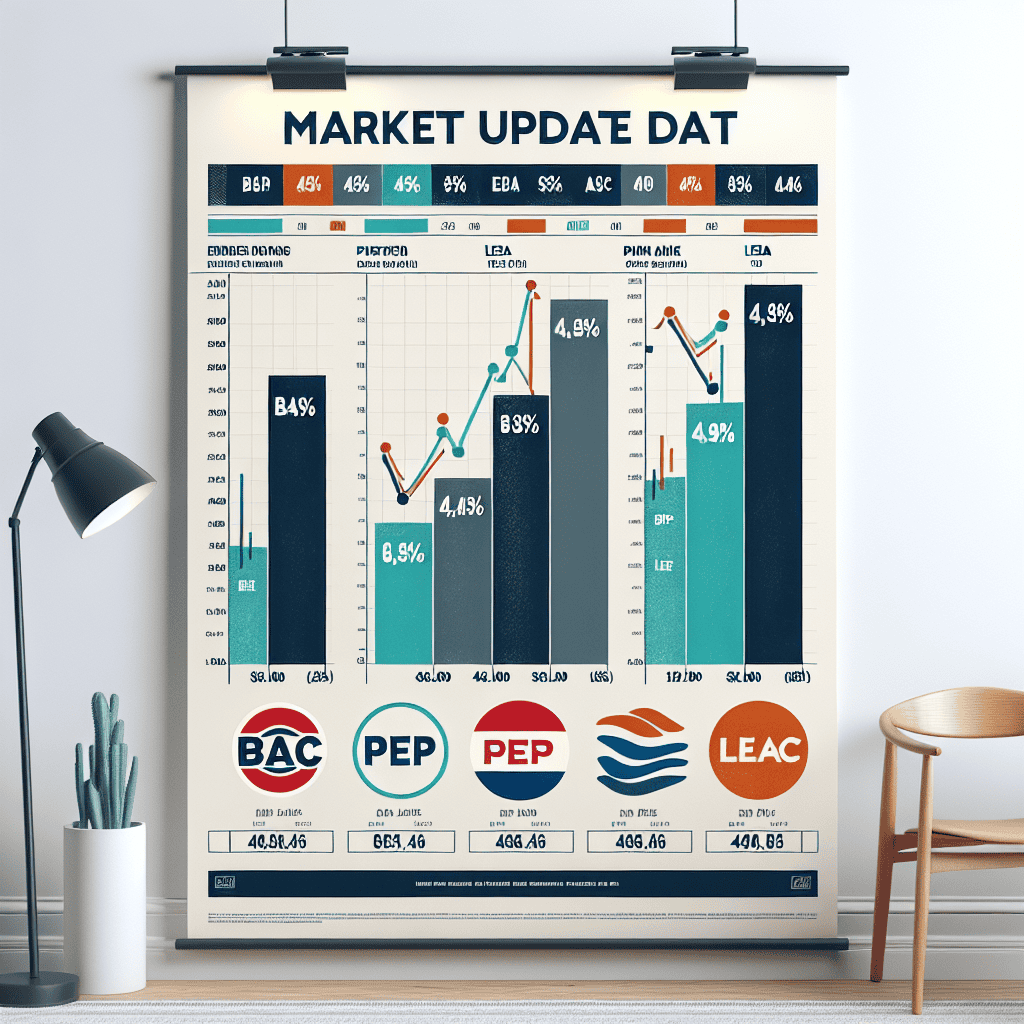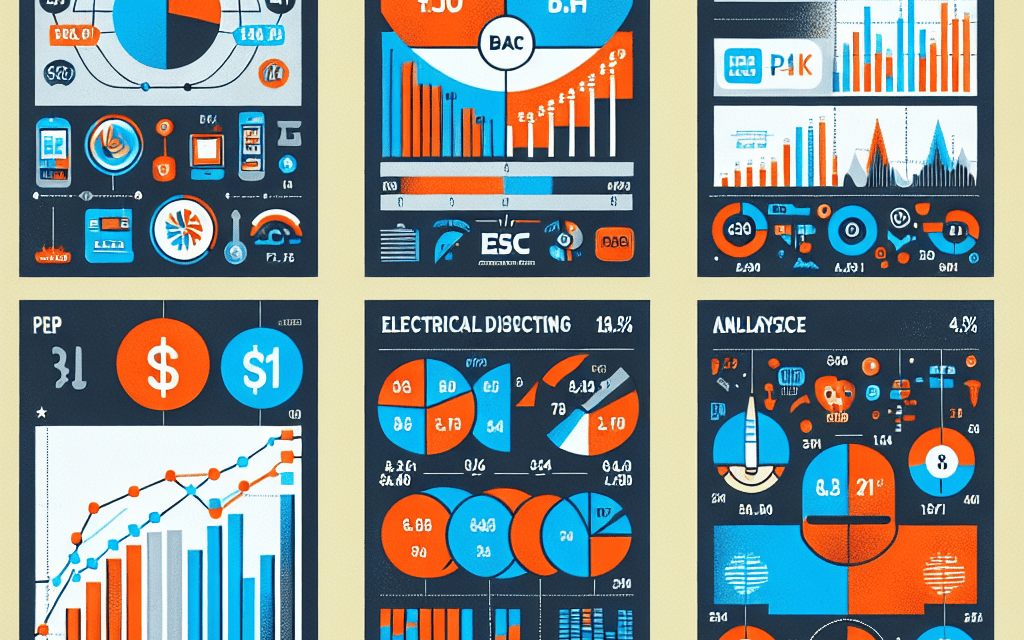“Stay Ahead: Dive into the Latest Market Moves with BAC, ERIC, PEP, PNC, and LEA!”
Introduction
In the latest market update, several key players in the financial and consumer sectors have made headlines with their recent performance and strategic moves. Bank of America (BAC) continues to navigate the evolving financial landscape, focusing on digital transformation and customer-centric services. Ericsson (ERIC), a leader in telecommunications, is advancing its 5G technology initiatives, impacting global connectivity. PepsiCo (PEP) remains a dominant force in the food and beverage industry, leveraging innovation and sustainability to drive growth. PNC Financial Services (PNC) is expanding its footprint through strategic acquisitions and enhanced banking solutions. Meanwhile, Lear Corporation (LEA), a major player in automotive technology, is pushing the boundaries of innovation in vehicle seating and electrical systems. These companies are at the forefront of their respective industries, each contributing to the dynamic shifts in the global market.
Bank Of America (BAC) Q3 Earnings Analysis: Key Takeaways
In the third quarter of 2023, Bank of America (BAC) reported its earnings, providing valuable insights into its financial health and strategic direction. The bank’s performance during this period is particularly noteworthy given the broader economic context, characterized by fluctuating interest rates and evolving regulatory landscapes. As we delve into the key takeaways from BAC’s Q3 earnings, it is essential to consider both the quantitative metrics and the qualitative factors that have influenced these results.
To begin with, Bank of America’s revenue for the third quarter showed a modest increase compared to the same period last year. This growth can be attributed to a combination of higher net interest income and a robust performance in its wealth management division. The bank’s ability to capitalize on rising interest rates has been a significant driver of its net interest income, as it has effectively managed its interest-earning assets and liabilities. Furthermore, the wealth management division has benefited from increased client engagement and a diversified product offering, which have collectively bolstered its revenue streams.
In terms of profitability, BAC’s net income for the quarter also experienced an uptick. This improvement is largely due to the bank’s disciplined cost management strategies and its focus on operational efficiency. By streamlining processes and leveraging technology, Bank of America has been able to reduce its operating expenses, thereby enhancing its bottom line. Additionally, the bank’s credit quality remains strong, with a low level of non-performing assets, which has further contributed to its solid financial performance.
However, it is important to note that Bank of America faces certain challenges that could impact its future earnings. The ongoing regulatory scrutiny in the financial sector poses a potential risk, as compliance costs and operational adjustments may affect profitability. Moreover, the competitive landscape in banking continues to evolve, with fintech companies and digital banks gaining traction. To address these challenges, BAC has been investing in digital transformation initiatives, aiming to enhance customer experience and improve operational agility.
Another critical aspect of Bank of America’s Q3 earnings is its capital position. The bank maintains a robust capital base, with capital ratios well above regulatory requirements. This strong capital position not only provides a buffer against potential economic downturns but also enables the bank to pursue growth opportunities, such as strategic acquisitions or investments in technology. Furthermore, BAC’s commitment to returning capital to shareholders is evident in its dividend policy and share repurchase programs, which have been well-received by investors.
Looking ahead, Bank of America’s strategic priorities include expanding its digital capabilities, enhancing customer engagement, and maintaining a disciplined approach to risk management. By focusing on these areas, the bank aims to sustain its growth trajectory and navigate the challenges of an increasingly complex financial environment. Moreover, BAC’s emphasis on environmental, social, and governance (ESG) initiatives underscores its commitment to sustainable business practices, which are becoming increasingly important to stakeholders.
In conclusion, Bank of America’s Q3 earnings report highlights its resilience and adaptability in a dynamic market environment. While the bank has demonstrated strong financial performance and strategic foresight, it must continue to address the challenges posed by regulatory changes and technological disruption. By leveraging its strengths and focusing on innovation, BAC is well-positioned to achieve long-term success and deliver value to its shareholders.
Ericsson (ERIC) Market Performance: A Comprehensive Update
In recent months, Ericsson (ERIC) has been a focal point of interest for investors and market analysts alike, as the telecommunications giant navigates a rapidly evolving industry landscape. As we delve into the market performance of Ericsson, it is essential to consider the broader context of the telecommunications sector, which has been characterized by both opportunities and challenges. The global push towards 5G technology has been a significant driver of growth for companies like Ericsson, as nations and corporations alike race to upgrade their infrastructure to accommodate faster and more reliable connectivity. This transition has provided Ericsson with a robust platform for expansion, as it continues to secure contracts and partnerships worldwide.
However, the journey has not been without its hurdles. The geopolitical tensions between major economies have introduced a layer of complexity to Ericsson’s operations, particularly in regions where regulatory scrutiny is heightened. Despite these challenges, Ericsson has demonstrated resilience, leveraging its technological expertise and strategic alliances to maintain a competitive edge. The company’s commitment to innovation is evident in its substantial investment in research and development, which has enabled it to stay at the forefront of technological advancements.
Financially, Ericsson’s recent quarterly reports have reflected a mixed performance, with some fluctuations in revenue and profit margins. These variations can be attributed to several factors, including supply chain disruptions and fluctuating demand in certain markets. Nevertheless, Ericsson’s management has expressed confidence in the company’s long-term growth prospects, citing a strong order backlog and a diversified portfolio of products and services as key strengths. Moreover, Ericsson’s strategic focus on expanding its digital services and cloud offerings has positioned it well to capitalize on the increasing demand for digital transformation solutions across various industries.
In addition to its core telecommunications business, Ericsson has been actively exploring opportunities in emerging markets, where the potential for growth is significant. By forging partnerships with local operators and governments, Ericsson aims to establish a strong foothold in these regions, thereby enhancing its global presence. This strategic approach not only diversifies Ericsson’s revenue streams but also mitigates risks associated with over-reliance on mature markets.
Furthermore, Ericsson’s commitment to sustainability and corporate responsibility has been a noteworthy aspect of its market strategy. The company has set ambitious targets to reduce its carbon footprint and promote sustainable practices across its operations. This focus on sustainability resonates well with investors and consumers who are increasingly prioritizing environmental, social, and governance (ESG) factors in their decision-making processes.
As we look ahead, the outlook for Ericsson remains cautiously optimistic. The ongoing rollout of 5G networks, coupled with the growing demand for digital solutions, presents significant opportunities for growth. However, the company must continue to navigate the complexities of the global market, including regulatory challenges and competitive pressures. By maintaining its focus on innovation, strategic partnerships, and sustainability, Ericsson is well-positioned to adapt to the changing dynamics of the telecommunications industry.
In conclusion, Ericsson’s market performance reflects a blend of resilience and adaptability in the face of both opportunities and challenges. As the company continues to evolve and expand its global footprint, it remains a key player in the telecommunications sector, poised to capitalize on the transformative potential of 5G technology and digital innovation.
PepsiCo (PEP) Financial Results: What Investors Need To Know
In the ever-evolving landscape of the stock market, investors are constantly seeking insights into the financial performance of major corporations. Among these, PepsiCo (PEP) stands out as a significant player in the consumer goods sector. As investors analyze the latest financial results of PepsiCo, several key aspects emerge that are crucial for understanding the company’s current position and future prospects.
To begin with, PepsiCo’s recent financial results have demonstrated a robust performance, reflecting the company’s strategic initiatives and market adaptability. The company’s revenue growth has been noteworthy, driven by strong demand across its diverse product portfolio. This growth is not only attributed to its flagship beverage brands but also to its expanding snack division, which continues to capture a significant share of the market. The diversification of PepsiCo’s product offerings has allowed it to mitigate risks associated with market fluctuations in any single category, thereby providing a stable revenue stream.
Moreover, PepsiCo’s commitment to innovation and sustainability has played a pivotal role in its financial success. The company has been investing heavily in research and development to introduce new products that cater to changing consumer preferences. This focus on innovation is evident in the launch of healthier snack options and low-calorie beverages, which have resonated well with health-conscious consumers. Additionally, PepsiCo’s sustainability initiatives, such as reducing plastic usage and improving water efficiency, have not only enhanced its brand image but also attracted environmentally conscious investors.
Transitioning to the financial metrics, PepsiCo’s earnings per share (EPS) have shown a positive trajectory, surpassing analysts’ expectations. This increase in EPS is indicative of the company’s operational efficiency and effective cost management strategies. Furthermore, PepsiCo’s strong cash flow generation has enabled it to maintain a healthy dividend payout, which remains an attractive feature for income-focused investors. The company’s ability to consistently return value to shareholders through dividends and share buybacks underscores its financial stability and confidence in future growth.
In addition to these financial highlights, PepsiCo’s global presence has been a significant factor in its sustained performance. The company’s strategic expansion into emerging markets has opened new avenues for growth, offsetting challenges in more saturated markets. By leveraging its extensive distribution network and local partnerships, PepsiCo has been able to penetrate new regions and adapt its products to local tastes and preferences. This global diversification not only enhances revenue potential but also reduces the impact of economic downturns in specific regions.
However, it is important to acknowledge the challenges that PepsiCo faces in the current economic environment. Rising input costs, supply chain disruptions, and fluctuating foreign exchange rates pose potential risks to the company’s profitability. Nevertheless, PepsiCo’s proactive measures, such as strategic pricing adjustments and supply chain optimization, are expected to mitigate these challenges to a certain extent.
In conclusion, PepsiCo’s recent financial results paint a picture of a resilient and forward-thinking company. Its ability to adapt to market trends, coupled with a strong focus on innovation and sustainability, positions it well for future growth. While challenges remain, PepsiCo’s strategic initiatives and global reach provide a solid foundation for continued success. Investors should keep a close eye on the company’s ongoing efforts to navigate the dynamic market landscape and capitalize on emerging opportunities.
PNC Financial Services (PNC) Stock Movement: Recent Trends

In recent months, PNC Financial Services (PNC) has experienced notable fluctuations in its stock performance, reflecting broader trends within the financial sector and the economy at large. As investors closely monitor the movements of PNC’s stock, several key factors have emerged as influential in shaping its trajectory. Understanding these elements is crucial for stakeholders aiming to make informed decisions in a dynamic market environment.
To begin with, PNC’s stock movement has been significantly impacted by macroeconomic conditions, particularly interest rate changes implemented by the Federal Reserve. As the central bank adjusts rates in response to inflationary pressures and economic growth indicators, financial institutions like PNC are directly affected. Higher interest rates generally lead to increased net interest margins for banks, potentially boosting profitability. However, they can also dampen loan demand, as borrowing costs rise for consumers and businesses. Consequently, PNC’s stock has shown sensitivity to announcements and projections related to monetary policy, with investors reacting to both actual rate changes and anticipated future adjustments.
Moreover, PNC’s strategic initiatives have played a pivotal role in its stock performance. The company’s efforts to expand its digital banking capabilities and enhance customer experience have been well-received by the market. In an era where digital transformation is paramount, PNC’s investments in technology have positioned it favorably among its peers. These initiatives not only improve operational efficiency but also attract a tech-savvy customer base, thereby driving growth. As a result, positive developments in PNC’s digital strategy have often been met with upward movements in its stock price, reflecting investor confidence in the company’s long-term vision.
In addition to internal strategies, PNC’s stock has been influenced by external competitive pressures. The financial services industry is highly competitive, with numerous players vying for market share. PNC’s ability to differentiate itself through unique product offerings and superior customer service has been a critical factor in maintaining its competitive edge. However, the entry of fintech companies and the increasing popularity of alternative financial solutions pose challenges that PNC must navigate. Investors are keenly aware of these dynamics, and any shifts in PNC’s competitive positioning can lead to corresponding changes in its stock valuation.
Furthermore, regulatory developments have also impacted PNC’s stock movement. The financial sector is subject to stringent regulations, and any changes in the regulatory landscape can have significant implications for banks. For instance, modifications in capital requirements or compliance standards can affect PNC’s operational flexibility and profitability. As such, investors closely watch for regulatory updates and assess their potential impact on PNC’s business model. Positive regulatory news can bolster investor sentiment, while adverse developments may lead to caution and stock price volatility.
Lastly, broader market trends and investor sentiment have contributed to PNC’s stock fluctuations. The financial sector is often seen as a barometer for economic health, and investor confidence in the economy can influence stock performance. During periods of economic optimism, financial stocks, including PNC, tend to perform well as investors anticipate increased lending activity and improved profitability. Conversely, during times of economic uncertainty, financial stocks may experience downward pressure as concerns about credit risk and loan defaults arise.
In conclusion, PNC Financial Services’ stock movement is shaped by a complex interplay of macroeconomic factors, strategic initiatives, competitive dynamics, regulatory changes, and market sentiment. As these elements continue to evolve, investors must remain vigilant and adaptable, recognizing that PNC’s stock performance is a reflection of both its internal strengths and external challenges. By staying informed and responsive to these trends, stakeholders can better navigate the intricacies of the financial market and make sound investment decisions.
Lear Corporation (LEA) Market Insights: Current Developments
In recent months, Lear Corporation (LEA) has been navigating a dynamic market environment, characterized by both challenges and opportunities. As a leading global supplier of automotive seating and electrical systems, Lear’s performance is closely tied to the automotive industry’s health and broader economic trends. The company has been actively adapting to the evolving landscape, focusing on innovation and strategic partnerships to maintain its competitive edge.
One of the key developments for Lear Corporation has been its commitment to sustainability and the integration of advanced technologies in its product offerings. As the automotive industry increasingly shifts towards electric vehicles (EVs) and sustainable practices, Lear has positioned itself as a pivotal player in this transformation. The company’s investment in research and development has led to the creation of cutting-edge seating solutions and electrical systems that cater to the unique needs of EVs. This strategic focus not only aligns with global environmental goals but also enhances Lear’s appeal to automakers seeking to meet stringent emissions regulations.
Moreover, Lear’s financial performance has been influenced by the fluctuating demand in the automotive sector. The company has demonstrated resilience by optimizing its operations and supply chain management. Despite facing challenges such as semiconductor shortages and rising raw material costs, Lear has managed to sustain its profitability through cost-control measures and strategic sourcing. This adaptability underscores Lear’s robust operational framework, which has been instrumental in mitigating the impact of external pressures.
In addition to its operational strategies, Lear Corporation has been actively pursuing strategic partnerships and acquisitions to bolster its market position. Collaborations with technology firms and other automotive suppliers have enabled Lear to expand its product portfolio and enhance its technological capabilities. These alliances are crucial in an era where connectivity and smart technologies are becoming integral to automotive design. By leveraging these partnerships, Lear is well-positioned to capitalize on emerging trends and deliver innovative solutions to its clients.
Furthermore, Lear’s commitment to enhancing shareholder value is evident in its capital allocation strategies. The company has maintained a balanced approach, reinvesting in growth initiatives while also returning capital to shareholders through dividends and share repurchases. This prudent financial management has garnered positive attention from investors, reflecting confidence in Lear’s long-term growth prospects.
Looking ahead, Lear Corporation is poised to continue its trajectory of growth and innovation. The company’s focus on sustainability, technological advancement, and strategic collaborations positions it favorably in the competitive automotive landscape. As the industry continues to evolve, Lear’s ability to adapt and innovate will be critical in maintaining its leadership position.
In conclusion, Lear Corporation’s recent developments highlight its proactive approach to navigating the complexities of the automotive market. By prioritizing sustainability, leveraging technology, and fostering strategic partnerships, Lear is not only addressing current challenges but also laying the groundwork for future success. As the company continues to execute its strategic initiatives, it remains a key player to watch in the automotive supply sector. Through its resilience and forward-thinking strategies, Lear Corporation is well-equipped to thrive in an ever-changing market environment, ensuring its continued relevance and competitiveness in the years to come.
Comparative Analysis Of BAC, ERIC, PEP, PNC, And LEA Stocks
In the ever-evolving landscape of the stock market, investors continuously seek to understand the performance and potential of various stocks. This analysis focuses on five notable companies: Bank of America (BAC), Ericsson (ERIC), PepsiCo (PEP), PNC Financial Services (PNC), and Lear Corporation (LEA). Each of these companies operates in distinct sectors, offering a diverse perspective on market trends and investment opportunities.
Starting with Bank of America, a major player in the financial services industry, its stock performance is often seen as a barometer for the broader economic climate. Recently, BAC has shown resilience amid fluctuating interest rates and regulatory changes. The bank’s strategic focus on digital transformation and cost management has bolstered its competitive position. Moreover, its robust capital base and diversified revenue streams provide a cushion against economic uncertainties. Investors are particularly attentive to BAC’s ability to navigate the challenges posed by inflationary pressures and potential shifts in monetary policy.
Transitioning to Ericsson, a leader in telecommunications, the company’s stock is influenced by the global rollout of 5G technology. ERIC has capitalized on the increasing demand for advanced network infrastructure, positioning itself as a key player in the digital revolution. The company’s strategic partnerships and investments in research and development have strengthened its market presence. However, geopolitical tensions and supply chain disruptions pose challenges that could impact its growth trajectory. Investors are keenly observing ERIC’s ability to maintain its competitive edge in a rapidly changing technological landscape.
In the consumer goods sector, PepsiCo stands out as a stalwart with a diverse product portfolio. PEP’s stock performance is underpinned by its strong brand recognition and global distribution network. The company’s focus on health-conscious products and sustainability initiatives resonates with evolving consumer preferences. Despite facing headwinds from rising commodity costs, PepsiCo’s strategic pricing and cost management efforts have helped sustain its profitability. Investors are optimistic about PEP’s long-term growth prospects, driven by innovation and expansion into emerging markets.
Turning to PNC Financial Services, the company’s stock is reflective of its solid financial foundation and strategic acquisitions. PNC’s emphasis on expanding its footprint through mergers and acquisitions has enhanced its market position. The bank’s prudent risk management and focus on customer-centric services have contributed to its steady performance. However, like its peers, PNC faces challenges from regulatory changes and economic volatility. Investors are closely monitoring PNC’s ability to integrate acquisitions and leverage synergies to drive growth.
Lastly, Lear Corporation, a prominent player in the automotive industry, offers insights into the sector’s transformation. LEA’s stock is influenced by trends in electric vehicles and autonomous driving technologies. The company’s focus on innovation and sustainability aligns with the industry’s shift towards greener solutions. Despite supply chain constraints and fluctuating raw material prices, Lear’s strategic partnerships and investments in advanced technologies position it for future growth. Investors are evaluating LEA’s capacity to adapt to industry disruptions and capitalize on emerging opportunities.
In conclusion, the comparative analysis of BAC, ERIC, PEP, PNC, and LEA stocks reveals a diverse array of opportunities and challenges across different sectors. Each company demonstrates unique strengths and faces distinct hurdles, reflecting broader market dynamics. As investors navigate the complexities of the stock market, understanding the nuances of these companies’ performances and strategies is crucial for making informed investment decisions. The interplay of economic factors, technological advancements, and consumer trends will continue to shape the trajectories of these stocks in the coming months.
Future Outlook For BAC, ERIC, PEP, PNC, And LEA In The Market
In the ever-evolving landscape of the financial markets, investors are constantly seeking insights into the future performance of key stocks. Among these, Bank of America (BAC), Ericsson (ERIC), PepsiCo (PEP), PNC Financial Services (PNC), and Lear Corporation (LEA) stand out as significant players, each with its unique set of opportunities and challenges. As we delve into the future outlook for these companies, it is essential to consider both the macroeconomic environment and company-specific factors that could influence their trajectories.
Starting with Bank of America, the financial giant is poised to benefit from a rising interest rate environment. As central banks around the world, particularly the Federal Reserve, continue to adjust rates in response to inflationary pressures, banks like BAC are likely to see improved net interest margins. This, in turn, could bolster profitability. However, it is crucial to remain cognizant of potential headwinds, such as regulatory changes and economic uncertainties, which could impact loan growth and credit quality. Nevertheless, Bank of America’s robust capital position and diversified revenue streams provide a solid foundation for navigating these challenges.
Turning to Ericsson, the telecommunications equipment provider is well-positioned to capitalize on the global rollout of 5G technology. As demand for faster and more reliable connectivity surges, Ericsson’s expertise in network infrastructure places it at the forefront of this technological revolution. The company’s strategic partnerships and investments in research and development further enhance its competitive edge. However, geopolitical tensions and supply chain disruptions remain potential risks that could affect Ericsson’s operations. Despite these challenges, the long-term prospects for ERIC appear promising, driven by the increasing adoption of 5G across various industries.
In the consumer goods sector, PepsiCo continues to demonstrate resilience and adaptability. The company’s diverse product portfolio, spanning beverages and snacks, allows it to cater to a wide range of consumer preferences. As health-conscious trends gain momentum, PepsiCo’s efforts to innovate and expand its offerings in the healthier product segment are noteworthy. Additionally, the company’s focus on sustainability and digital transformation initiatives positions it well for future growth. Nevertheless, PepsiCo must navigate challenges such as fluctuating commodity prices and changing consumer behaviors. Overall, PEP’s strong brand equity and strategic initiatives provide a positive outlook for the future.
Meanwhile, PNC Financial Services is another key player in the banking sector, with a focus on expanding its footprint through strategic acquisitions and digital innovation. The acquisition of BBVA USA has significantly enhanced PNC’s presence in key markets, providing opportunities for revenue growth and operational synergies. As with BAC, PNC stands to benefit from a favorable interest rate environment, although it must also contend with potential regulatory and economic challenges. The bank’s commitment to technology-driven solutions and customer-centric strategies bodes well for its long-term prospects.
Lastly, Lear Corporation, a leading supplier of automotive seating and electrical systems, is navigating a rapidly changing automotive industry. The shift towards electric vehicles (EVs) presents both opportunities and challenges for LEA. On one hand, the increasing demand for EVs drives the need for advanced electrical systems, a domain where Lear excels. On the other hand, the transition requires significant investments in innovation and adaptation to new technologies. Despite these challenges, Lear’s strong relationships with major automakers and its focus on sustainability initiatives position it favorably for future growth.
In conclusion, while each of these companies faces its own set of challenges and opportunities, their strategic initiatives and market positions provide a foundation for potential growth. Investors should remain vigilant, considering both macroeconomic trends and company-specific factors, as they assess the future outlook for BAC, ERIC, PEP, PNC, and LEA in the market.
Q&A
1. **BAC (Bank of America) Market Update:**
– Q: How did Bank of America’s stock perform recently?
– A: Bank of America’s stock has shown mixed performance, with fluctuations influenced by interest rate changes and economic outlooks.
2. **ERIC (Ericsson) Market Update:**
– Q: What recent developments have affected Ericsson’s market position?
– A: Ericsson’s market position has been impacted by geopolitical tensions and competition in the 5G infrastructure space.
3. **PEP (PepsiCo) Market Update:**
– Q: How has PepsiCo’s stock been performing in the market?
– A: PepsiCo’s stock has been relatively stable, supported by strong earnings and diversified product offerings.
4. **PNC (PNC Financial Services) Market Update:**
– Q: What factors are influencing PNC Financial Services’ stock performance?
– A: PNC’s stock performance is influenced by interest rate trends and its strategic acquisitions to expand its market presence.
5. **LEA (Lear Corporation) Market Update:**
– Q: What recent trends are affecting Lear Corporation’s market performance?
– A: Lear Corporation’s market performance is affected by supply chain challenges and demand fluctuations in the automotive sector.
6. **BAC (Bank of America) Earnings Report:**
– Q: What were the highlights of Bank of America’s latest earnings report?
– A: Bank of America reported strong earnings driven by higher net interest income and cost management efforts.
7. **PEP (PepsiCo) Earnings Report:**
– Q: What key points were noted in PepsiCo’s recent earnings report?
– A: PepsiCo’s earnings report highlighted revenue growth across its snack and beverage segments, with a focus on innovation and sustainability.
Conclusion
In the latest market update, Bank of America (BAC) showed resilience with steady financial performance, driven by strong consumer banking and wealth management segments. Ericsson (ERIC) faced challenges due to competitive pressures and geopolitical tensions affecting its 5G rollout, impacting its market position. PepsiCo (PEP) continued to demonstrate robust growth, supported by its diversified product portfolio and strategic investments in healthier options. PNC Financial Services (PNC) maintained a solid performance, benefiting from its strategic acquisitions and focus on digital banking innovations. Lear Corporation (LEA) experienced mixed results, with automotive industry fluctuations affecting its seating and e-systems segments. Overall, these companies reflect a diverse range of market dynamics, with varying degrees of success and challenges in their respective sectors.





